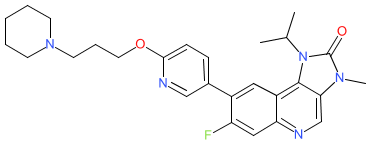GtoPdb is requesting financial support from commercial users. Please see our sustainability page for more information.
|
Compound class:
Synthetic organic
Comment: AZD1390 is an oral, brain-penetrant ATM kinase inhibitor [2]. Structurally, AZD1390 is from the same chemical series as AZD0156, but is optimised to cross the blood-brain barrier [3-4]. Mechanistically, blocking ATM disrupts DNA damage repair and sensitises cancer cells to radiotherapy. This induces G2 cell cycle arrest and the development of micronuclei, and ultimately leads to apoptosis. Experimental evidence suggests that AZD1390 is able to promote neurite outgrowth in vitro, and axon regeneration and functional recovery in in vivo models of spinal cord injury [1].
Ligand Activity Visualisation ChartsThese are box plot that provide a unique visualisation, summarising all the activity data for a ligand taken from ChEMBL and GtoPdb across multiple targets and species. Click on a plot to see the median, interquartile range, low and high data points. A value of zero indicates that no data are available. A separate chart is created for each target, and where possible the algorithm tries to merge ChEMBL and GtoPdb targets by matching them on name and UniProt accession, for each available species. However, please note that inconsistency in naming of targets may lead to data for the same target being reported across multiple charts. ✖ |
|
|||||||||||||||||
| No information available. |
Summary of Clinical Use  |
| AZD1390 has been advanced to clinical trials for non-small cell lung cancer and glioblastoma. |
| Clinical Trials | |||||
| Clinical Trial ID | Title | Type | Source | Comment | References |
| NCT04550104 | A Platform Study of Novel Agents in Combination With Radiotherapy in NSCLC | Phase 1 Interventional | University of Leeds | ||
| NCT03423628 | A Study to Assess the Safety and Tolerability of AZD1390 Given With Radiation Therapy in Patients With Brain Cancer | Phase 1 Interventional | AstraZeneca | ||






